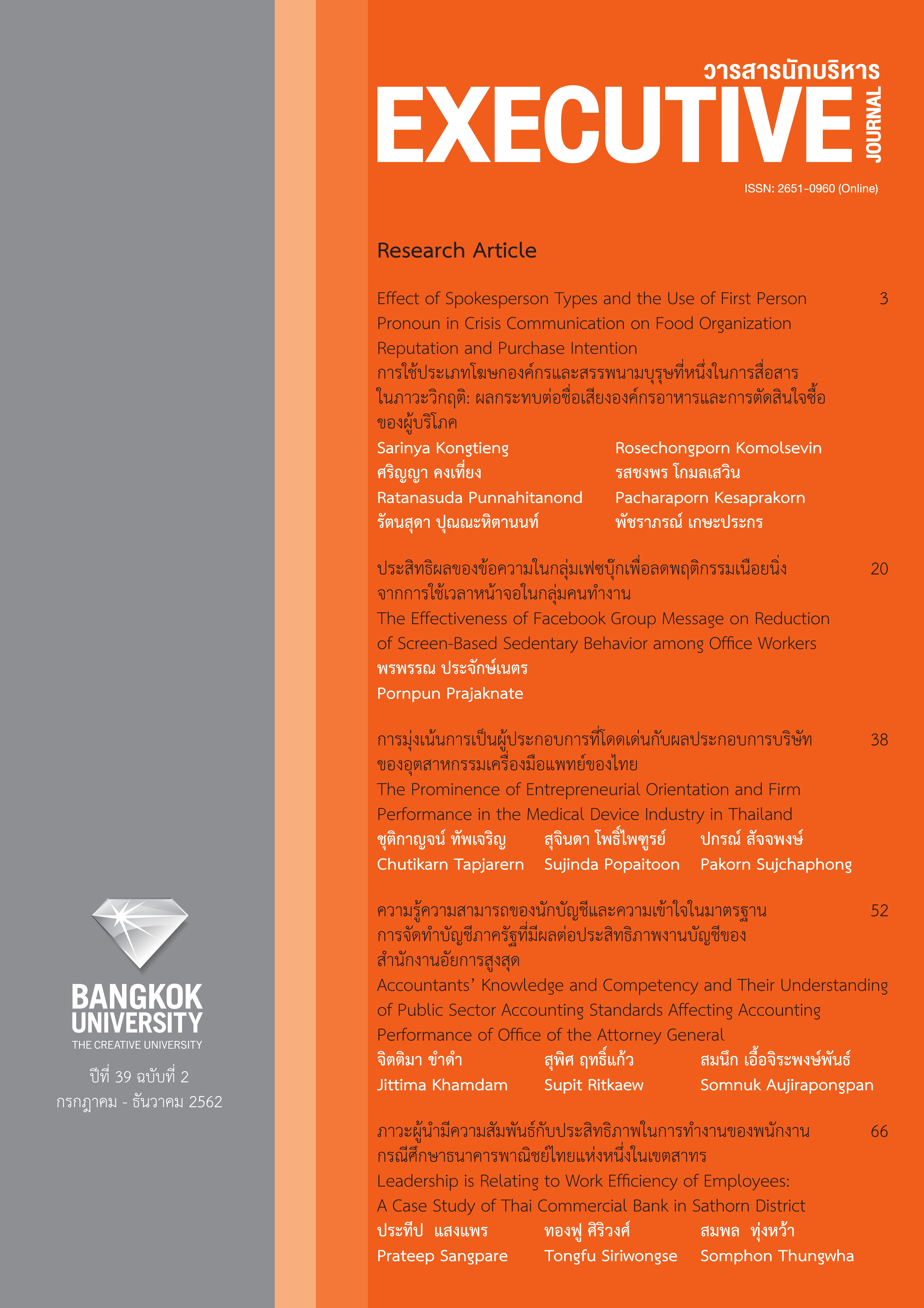การมุ่งเน้นการเป็นผู้ประกอบการที่โดดเด่นกับผลประกอบการบริษัทของอุตสาหกรรมเครื่องมือแพทย์ของไทย
Main Article Content
บทคัดย่อ
งานวิจัยนี้มีวัตถุประสงค์เพื่อ 1) ศึกษาอิทธิพลของ 5 ลักษณะการมุ่งเน้นการเป็นผู้ประกอบการ (การทำงานเชิงรุก การแข่งขันเชิงรุก การสร้างนวัตกรรม ความเป็นอิสระ และความกล้าเสี่ยง) กับผลประกอบการบริษัทเครื่องมือแพทย์ของประเทศไทย และ 2) ศึกษาลักษณะการมุ่งเน้นการเป็นผู้ประกอบการที่โดดเด่นในเชิงลึก ดังนั้น งานวิจัยนี้เป็นการวิจัยแบบผสมผสาน เริ่มจากงานวิจัยเชิงปริมาณด้วยการใช้แบบสอบถามเก็บข้อมูลจากประธานเจ้าหน้าที่บริหาร กรรมการผู้จัดการ และผู้จัดการแผนกของบริษัทจำนวน 74 บริษัท โดยวิเคราะห์การถดถอยแบบพหุคูณ ผลจากแบบสอบถามพบว่า การมุ่งเน้นการเป็นผู้ประกอบการที่โดดเด่นของอุตสาหกรรมเครื่องมือแพทย์ไทย คือ การทำงานเชิงรุกซึ่งส่งผลเชิงบวกต่อผลประกอบการบริษัทอย่างมีนัยสำคัญทางสถิติที่ระดับ 0.10 ในขณะที่การแข่งขันเชิงรุกส่งผลเชิงลบต่อผลประกอบการบริษัทอย่างมีนัยสำคัญทางสถิติที่ระดับ 0.10 จากนั้นดำเนินการวิจัยเชิงคุณภาพแบบกรณีศึกษา โดยวิธีสัมภาษณ์เชิงลึกด้วยคำถามกึ่งโครงสร้างกับผู้จัดการบริษัทผู้ผลิตเครื่องมือแพทย์จำนวน 5 บริษัทซึ่งพบว่า 1) ลักษณะการทำงานเชิงรุกของบริษัทเครื่องมือแพทย์ คือ การส่งออกสินค้าไปต่างประเทศซึ่งช่วยเพิ่มยอดขาย เพิ่มความคุ้มค่าการใช้ทรัพยากรที่มี และหลีกเลี่ยงสงครามราคาในตลาดปัจจุบัน ซึ่งทำลายความสามารถในการทำกำไรในอนาคต และ 2) การแข่งขันเชิงรุกของบริษัทเครื่องมือแพทย์มีลักษณะเฉพาะต่างจากอุตสาหกรรมที่ใช้เทคโนโลยีระดับสูงอื่นๆ เพราะมุ่งเน้นการสร้างนวัตกรรมเพื่อจดสิทธิบัตร เพื่อรักษาพื้นที่การแข่งขันในระยะยาวเป็นสำคัญ
Article Details
บทความที่นำมาสมัครลงตีพิมพ์ในวารสารต้องไม่เคยได้รับการตีพิมพ์เผยแพร่มาก่อน และไม่ส่งต้นฉบับบทความซ้ำซ้อนกับวารสารอื่น รวมทั้งผู้เขียนบทความต้องไม่ละเมิดหรือคัดลอกผลงานของผู้อื่น
References
Avlonitis, G. J., & Salavou, H. E. (2007). Entrepreneurial orientation of SMEs, product innovativeness. and performance. Journal of Business Research, 60(5), 566-575.
Baruch, Y., & Holtom, B. C. (2008). Survey response rate levels and trends in organizational research. Human Relations, 61(8), 1139-1160.
Bonaccorsi, A., Lyon, T. P., Pammolli, F., & Turchetti, G. (2000). Auctions vs. bargaining: An empirical analysis of medical device procurement. Bargaining: An Empirical Analysis of Medical Device Procurement (January 19, 2000).
Bridy, A. (2008). Trade secret prices and high-tech devices: How medical device manufacturers are seeking to sustain profits by propertizing prices. Tex. Intell. Prop. LJ, 17, 187.
Cadogan, J. W., Boso, N., Story, V. M., & Adeola, O. (2016). Export strategic orientation–performance relationship: Examination of its enabling and disenabling boundary conditions. Journal of Business Research, 69(11), 5046-5052.
Chakravarthy, B. S. (1986). Measuring strategic performance. Strategic Management Journal, 7(5), 437-458.
Covin, J. G., & Slevin, D. P. (1989). Strategic management of small firms in hostile and benign environments. Strategic Management Journal, 10(1), 75-87.
Cutler, D. M., & McClellan, M. (2001). Is technological change in medicine worth it?. Health affairs, 20(5), 11-29.
Dai, L., Maksimov, V., Gilbert, B. A., & Fernhaber, S. A. (2014). Entrepreneurial orientation and international scope: The differential roles of innovativeness, proactiveness, and risk-taking. Journal of Business Venturing, 29(4), 511-524.
Dubey, R., & Dubey, J. (2009). Pharmaceutical product differentiation: A strategy for strengthening product pipeline and life cycle management. Journal of Medical Marketing, 9(2), 104-118.
Frishammar, J., & Ake Hörte, S. (2007). The role of market orientation and entrepreneurial orientation for new product development performance in manufacturing firms. Technology Analysis & Strategic Management, 19(6), 765-788.
George, D., &. Mallery, P. (2003). SPSS for Windows step by step: A simple guide and reference 11.00 update (4th ed.). Boston: Allyn & Bacon.
Guo, Z., & Jiang, W. (2019). Risk-taking for entrepreneurial new entry: Risk-taking dimensions and contingencies. International Entrepreneurship and Management Journal, 1-43.
Hair, J. F., Black, W. C., Babin, B. J., Anderson, R. E., & Tatham, R. L. (2006). Multivariate data analysis (6 th ed.). New Jersey: Pearson Prentice Hall.
Harris, R. J. (2001). A primer of multivariate statistics (3rd ed.). Mahwah, NJ: Erlbaum.
Kallmuenzer, A., & Peters, M. (2018). Innovativeness and control mechanisms in tourism and hospitality family firms: A comparative study. International Journal of Hospitality Management, 70, 66-74.
Kocak, A., Carsrud, A., & Oflazoglu, S. (2017). Market, entrepreneurial, and technology orientations: Impact on innovation and firm performance. Management Decision, 55(2), 248-270.
Lechner, C., & Gudmundsson, S. V. (2014). Entrepreneurial orientation, firm strategy and small firm performance. International Small Business Journal, 32(1), 36-60.
Li, Y., Liu, X., Wang, L., Li, M., & Guo, H. (2009). How entrepreneurial orientation moderates the effects of knowledge management on innovation. Systems Research and Behavioral Science, 26(6), 645-660.
Lumpkin, G. T., & Dess, G. G. (1996). Clarifying the entrepreneurial orientation construct and linking it to performance. Academy of Management Review, 21(1), 135-172.
Lumpkin, G. T., & Dess, G. G. (2001). Linking two dimensions of entrepreneurial orientation to firm performance: The moderating role of environment and industry life cycle. Journal of Business Venturing, 16(5), 429-451.
Luo, Y., Hu, Z., & Yu, K. (2018). The impact of the R&D expenditure and patent rights towards operating Performance in medical device Industry–An empirical study. Revista de Cercetare si Interventie Sociala, 61, 187-197.
Masa’deh, R., Al-Henzab, J., Tarhini, A., & Obeidat, B. Y. (2018). The associations among market orientation, technology orientation, entrepreneurial orientation and organizational performance. Benchmarking: An International Journal, 25(8), 3117-3142.
Miller, D. (1983). The correlates of entrepreneurship in three types of firms. Management Science, 29(7), 770–791.
Morris, M. H., & Paul, G. W. (1987). The relationship between entrepreneurship and marketing in established firms. Journal of Business Venturing, 2(3), 247-259.
Murphy, G. B., Trailer, J. W., & Hill, R. C. (1996). Measuring performance in entrepreneurship research. Journal of Business Research, 36(1), 15–23.
National Science and Technology Development Agency. (2017). Rāingānkānsưksāʻutsāhakam khrư̄angmư̄phǣtkhō̜ngprathed [Study report of the medical device industry in Thailand]. Retrieved April 18, 2018, from https://waa.inter.nstda.or.th/prs/pub/Final-Report-Medical-Device.pdf
Office of Industrial Economics. (n.d.). Rāi chư̄ phūprakō̜pkān klum watsadu thāng kānphǣt [List of medical device operators]. Retrieved April 18, 2018, from https://medicaldevices.oie.go.th/CompanyList.aspx?tid=2&id=1
Parida, V., Westerberg, M., & Frishammar, J. (2012). Inbound open innovation activities in high‐tech SMEs: the impact on innovation performance. Journal of Small Business Management, 50(2), 283-309.
Plastics Institutes of Thailand. (2015). ʻUtsāhakam klum watsadu sin plư̄ngō̜ thāng kānphǣt khō̜ng Thai [Thai disposable medical device industry]. Retrieved April 20, 2018, from https://www.thaiplastics.org/content_attachment/attach/1468318180.21-41_.1-10_.pdf
Robinson, J. C. (2015). Biomedical innovation in the era of health care spending constraints. Health Affairs, 34(2), 203-209.
Shan, P., Song, M., & Ju, X. (2016). Entrepreneurial orientation and performance: Is innovation speed a missing link?. Journal of Business Research, 69(2), 683-690.
Simmons, J. D. (2010). The effects of firm size on the entrepreneurial orientation dimensions of innovativeness, proactiveness, and risk-taking (Doctoral dissertation, Ohio University).
Turner, R. C., & Carlson, L. (2003). Indexes of item-objective congruence for multidimensional items. International Journal of Testing, 3(2), 163-171.
Wales, W. J. (2016). Entrepreneurial orientation: A review and synthesis of promising research directions. International Small Business Journal, 34(1), 3-15.
Yin, R. K. (1992). The case study method as a tool for doing evaluation. Current Sociology, 40(1), 121-137.
Yin, R. K. (2013). Validity and generalization in future case study evaluations. Evaluation, 19(3), 321 332.
Zahra, S. A., & Garvis, D. M. (2000). International corporate entrepreneurship and firm performance: The moderating effect of international environmental hostility. Journal of Business Venturing, 15(5-6), 469-492.
Zellweger, T., & Sieger, P. (2012). Entrepreneurial orientation in long-lived family firms. Small Business Economics, 38(1), 67-84.

